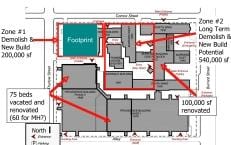The revitalization of St Paul’s Hospital on Burrard St could be complete by 2016 and will include the demolition of several buildings and the addition of a 10- or 11-storey tower at the corner of Comox and Thurlow streets, Providence Health Care officials say.
And, says Vancouver-West End MLA Spencer Chandra Herbert, the project could be done for $300-$500 million, half the rumoured billion-dollar cost of a new hospital at the formerly proposed Station St site.
Providence president and CEO Dianne Doyle says the new work must involve stakeholders, including the community and people inside and outside the hospital, to ensure St Paul’s can provide service for another 100 years.
“The facility is being designed to reflect and support the kind of care we want to provide,” Doyle says. “What we’re trying to create is a new vision, a new organization that will keep us going for a long time.”
That will include better ambulatory care, research, mental health and addiction service, cardiac care and support for people with HIV/AIDS, she stressed.
The plans were met with applause at an Oct 21 community meeting attended by about 30 people.
The revitalization was up in the air for years until June 3 when Health Minister Kevin Falcon suddenly announced the project would proceed on the current site.
“We had a period of uncertainty,” Doyle says. “Now, we have a certainty of direction.”
The issue of possibly relocating St Paul’s first arose in 2003, to the dismay of many West End residents. Gay people, seniors and their neighbours formed a coalition to save the hospital. Members expressed concern about the gay village losing vital healthcare services, not to mention a major economic engine.
But, says Neil MacConnell, vice-president of strategic development and renewal for Providence Health Care, which operates St Paul’s, the redevelopment goes back to the 1970s when renovations began on portions of the hospital. That continued into the 1980s with the construction of the tower, he says.
The current revitalization is a continuation of phase three of that work, which became stalled, MacConnell says.
The building off the corner of Comox and Thurlow streets will be demolished to create a tower with 200,000 square feet of space. MacConnell says it will house ambulatory care, which is currently spread throughout the hospital.
“Very inefficient,” he notes.
That change will free up space in the current tower, which will then house 60 mental-health beds, he adds.
The old powerhouse will also be demolished, as will the McDonald Building and portions of others.
The new tower will integrate research and care for minor procedures, current disease management, primary care, outpatient clinics, point of care diagnostics, research and academics, MacConnell says.
“It would be much, much more efficient,” he says. “We can integrate all of this into one building. It would be a one-stop shop.”
All the elevators will be replaced too, he adds.
Audience members were curious about what will happen to the land on Station St.
In June, Xtra reported the BC Liberal government has spent millions paying property taxes on the False Creek land.
The land belongs to the Esperanza Society, a private group with ties to the BC Liberals, Providence and Vancouver Coastal Health Authority.
Doyle says the society was formed as an arm’s-length group from Providence for the purchasing of the land for hospital usage.
“It’s still a highly valuable asset,” she says. “It’s certainly increased in value from a monetary point of view, and it will continue to appreciate.
“We always envisioned that property would be some kind of leverage, some asset to offset capital costs.”
Falcon has said the land might still be used for another hospital.
But, says Doyle, “we have had no dialogue, no signal what that usage might be.”
With the preliminary plans in hand, MacConnell says Providence now has to go to the government with a concept plan. By early next year, he hopes a business plan will be in place.
Preparing that plan is expected to cost about $3 million.
Demolition could begin in 2012 with construction starting in 2013 and continuing for two years. Work, including moving, should be completed by 2016, MacConnell says.
Chandra Herbert stressed the community needs to get behind the project now as the battle over healthcare dollars in the province is heating up.
“There’s a lot of other projects out there vying for the money,” MacConnell adds.

 Why you can trust Xtra
Why you can trust Xtra


